Last updated: 7th January 2022
Table of Contents
Exploring The Garden Route en route from Port Elizabeth to Cape Town
After our amazing safari trip we flew from Johannesburg to Port Elizabeth where we spent the night before setting off the next day along ‘The Garden Route’. This is South Africa’s famous scenic and iconic road trip – 125 miles long which takes you through along one of the most beautiful stretches of coastline in the world. There’s lots of lovely towns to stop off along the way plus plenty of outdoor activities such as hiking in national parks, birdwatching in indigenous forests, whale watching and more.
At times we felt like we were in the Scottish highlands or California but then the tropical plants reappear and tell you otherwise. The Garden Route officially runs from Stormsrivier in the East to Mossel Bay in the West (depending on which way you are travelling)
The Garden Route 4 Day Itinerary:
- Day 1: Port Elizabeth > Tsitsikamma National Park > Plettenberg Bay
- Day 2: Plettenburg Bay
- Day 3: Plettenburg Bay > Knysna
- Day 4: Knysna > Wilderness > Hermanus
- After taking the Garden Route, this is how we spent the next 3 days:
- Day 5: Hermanus
- Day 6: Hermanus > Stellenbosch
- Day 7: Stellenbosch > Cape Point > Cape Town
Google Map of The Garden Route
Day 1: Tsitsikamma National Park
Driving the Garden Route would not be complete without stopping off at Tsitsikamma National Park and walking one of the day trails. It’s known as the ‘garden’ of the Garden Route because it’s all about the great outdoors! The park is impressive with its deep gorges, lush forest background and a dramatic rocky shoreline.

Tsitsikamma National Park on the Garden Route
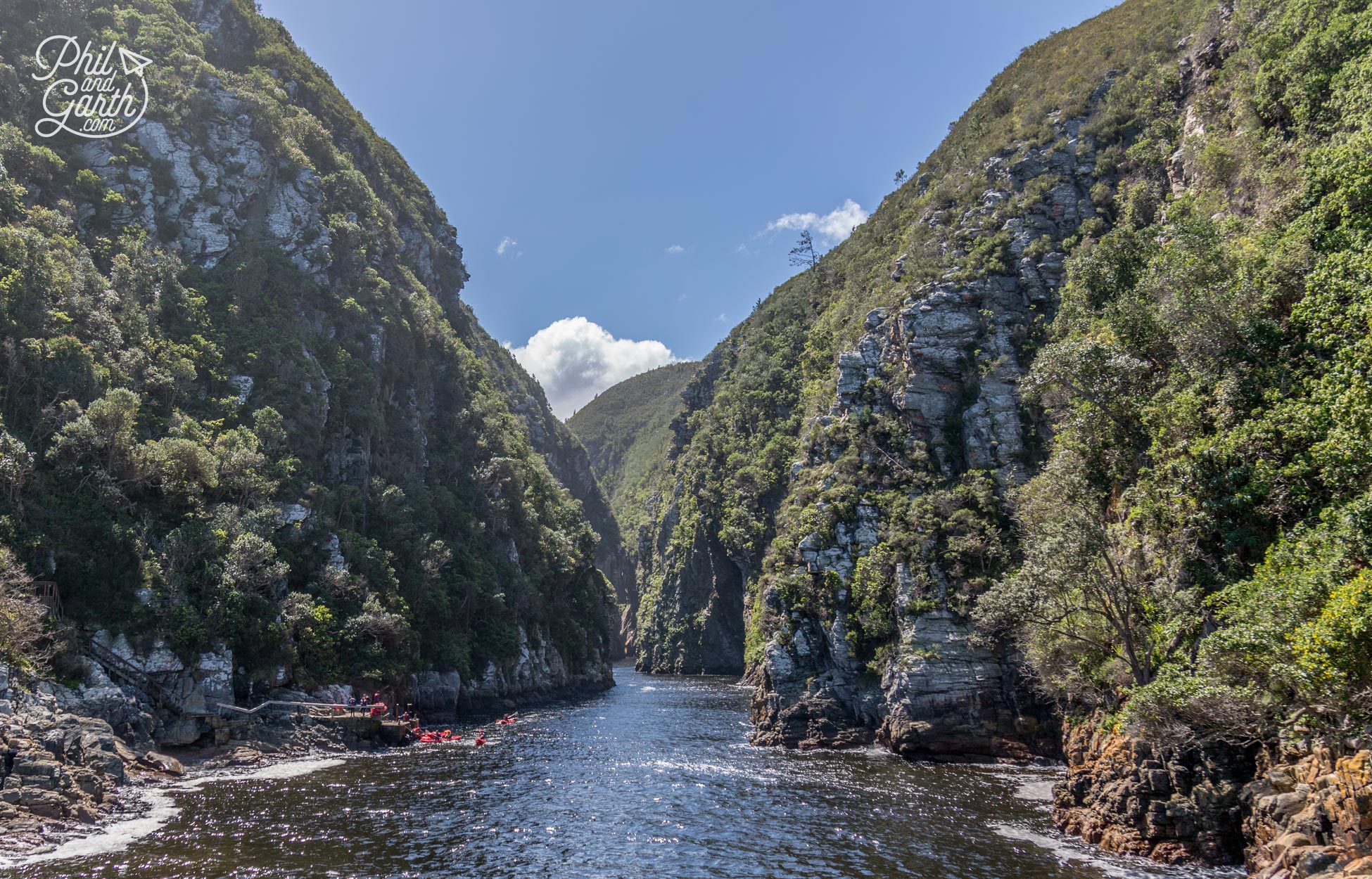
Kayaking, snorkelling and scuba opportunities in the gorge – ask at the boat house

Suspension bridges across the Storms River – the first one was built in 1969
From the Storms River Most Rest Camp we took the easy ‘Mouth Trail’ a 1 hour circular trail along the rocky coastal cliff which takes you past some secluded waterfalls and over the Storms River via picturesque suspension bridges, so there’s tons of Instagrammable spots here! We really enjoyed the walk here. There’s lots more challenging trails for serious hikers, plus a famous hike in South Africa called ‘The Otter Trail’ which takes 5 days to complete over 26 miles. (You have to book it in advance)

Boardwalks guide you through the park

Phil and Garth on a suspension bridge at Tsitsikamma
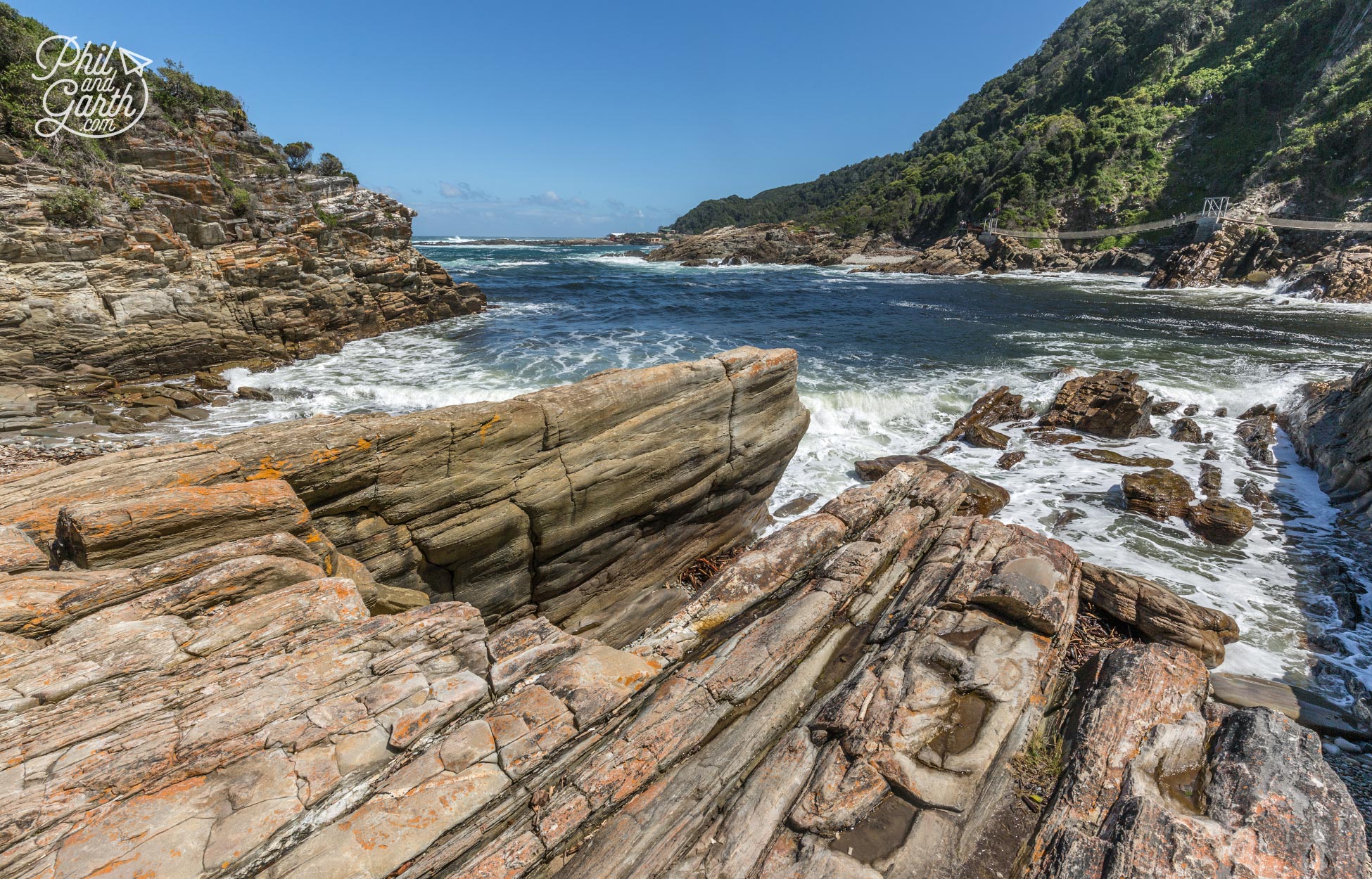
Beautiful seascapes contrast against the indigenous forest backdrop (pic taken from the plateau lookout point)

Tremendous power in the waves crashing against the rocks
Garth loved the power of the waves of the Indian Ocean crashing against the rocky shore – a photographer’s dream! Phil watched on with a glass of wine in hand from the restaurant trying to spot dolphins in the breaking waves.
Bloukrans Bungy
Tsitsikamma is also very close to Bloukrans Bungy where adrenaline junkies can jump off the top of Africa’s biggest bridge. We stopped off to watch various people bungeeeeeeeeee! Just stomach churning stuff as people fall off the platform into the gorge below! and the thought of how people get there by walking under that bridge! No thanks, we’ll both pass on that one!

Thrill seekers will love Bloukrans Bungy from Africa’s biggest bridge

Bungee from the world’s 3rd tallest – 216 metres
We then drove on to stay the night in Plettenberg Bay (or Plett as locals call it) it’s a 1 hour 30 minute drive from Tsitsikamma.
Day 2: Plettenburg Bay

Beautiful Plettenburg Bay, beaches have miles and miles of golden sand
Plettenburg Bay is a prestigious coastal resort with golf courses and big mansions, its best feature are the stunning unspoilt beaches with miles of golden sand. In the summer it gets really busy with beach goers. It’s also a great place to watch whales breaching from June to September just like Hermanus further down the coast.
Robberg Nature Reserve
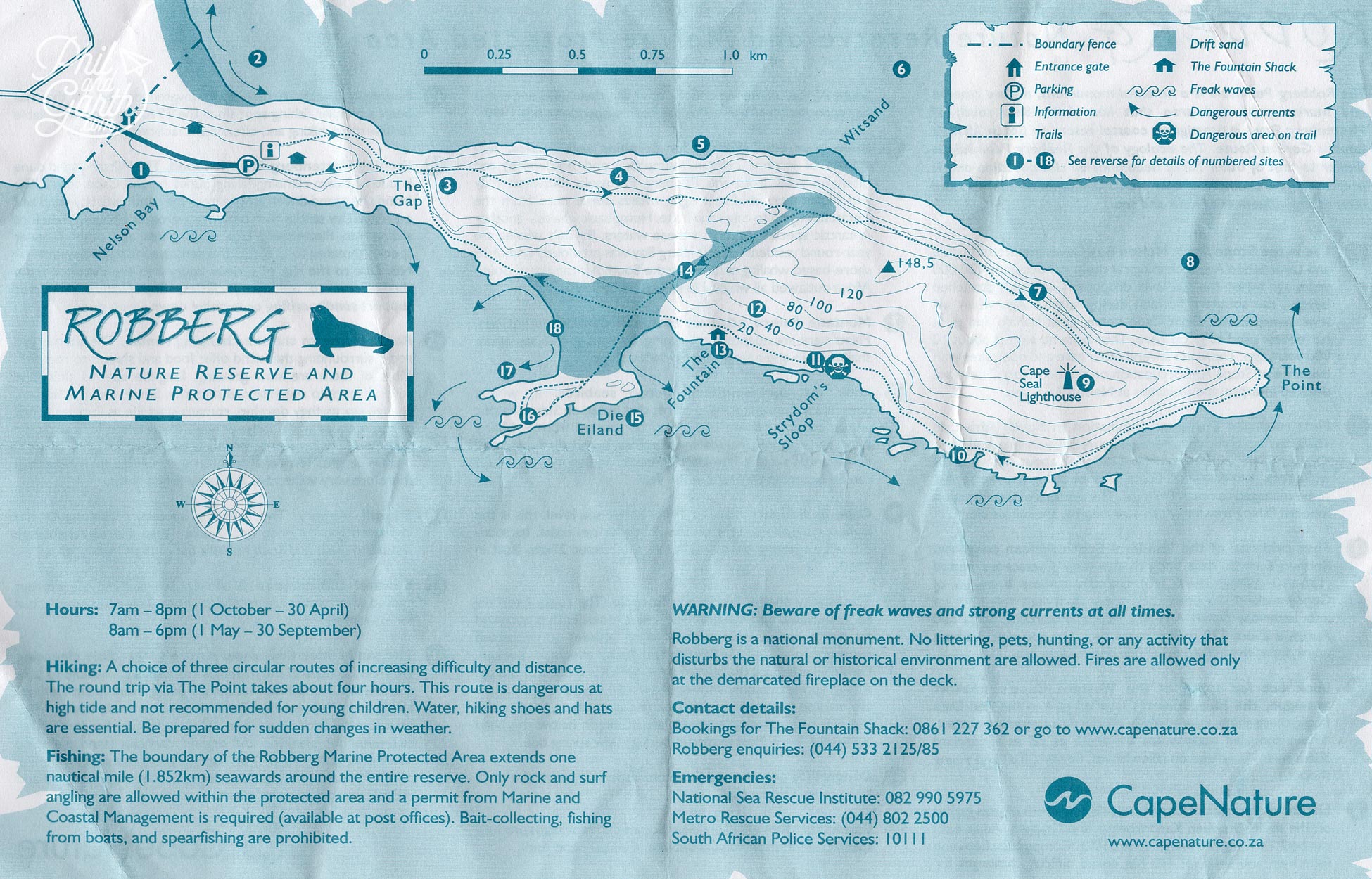
Robberg Nature Reserve map
We did a hike on the Robberg peninsula, through the Robberg Nature Reserve which is a UNESCO World Heritage Site. There are 3 circular trails to choose from, each with increasing difficulty and distance:
- 1.5 mile The Gap – Hike to the narrowest point with views to both sides then you can spend time on the beach.
- 3.5 mile Witsand sand dunes – Follows the northern ridge which is good for spotting seals.
- 6.8 mile The Round Trip – The whole peninsula trail takes 5 hours and is tough and dangerous at high tide.

Wildflowers at Robberg Nature Reserve in Spring (September-December)

Just one of the many gorgeous views at the Robberg Nature Reserve
Along our walk the scenery is just beautiful and constantly changes as does the terrain. It was challenging in parts for us as we’re both so unfit! Especially when faced with some really steep and rocky slopes to deal with. Robberg is popular so you also have to deal with people passing you in tighter spots. But we loved it, amazing views across the sea where we caught sight of the odd seal. We were also lucky to see dolphins and a whale in the distance.
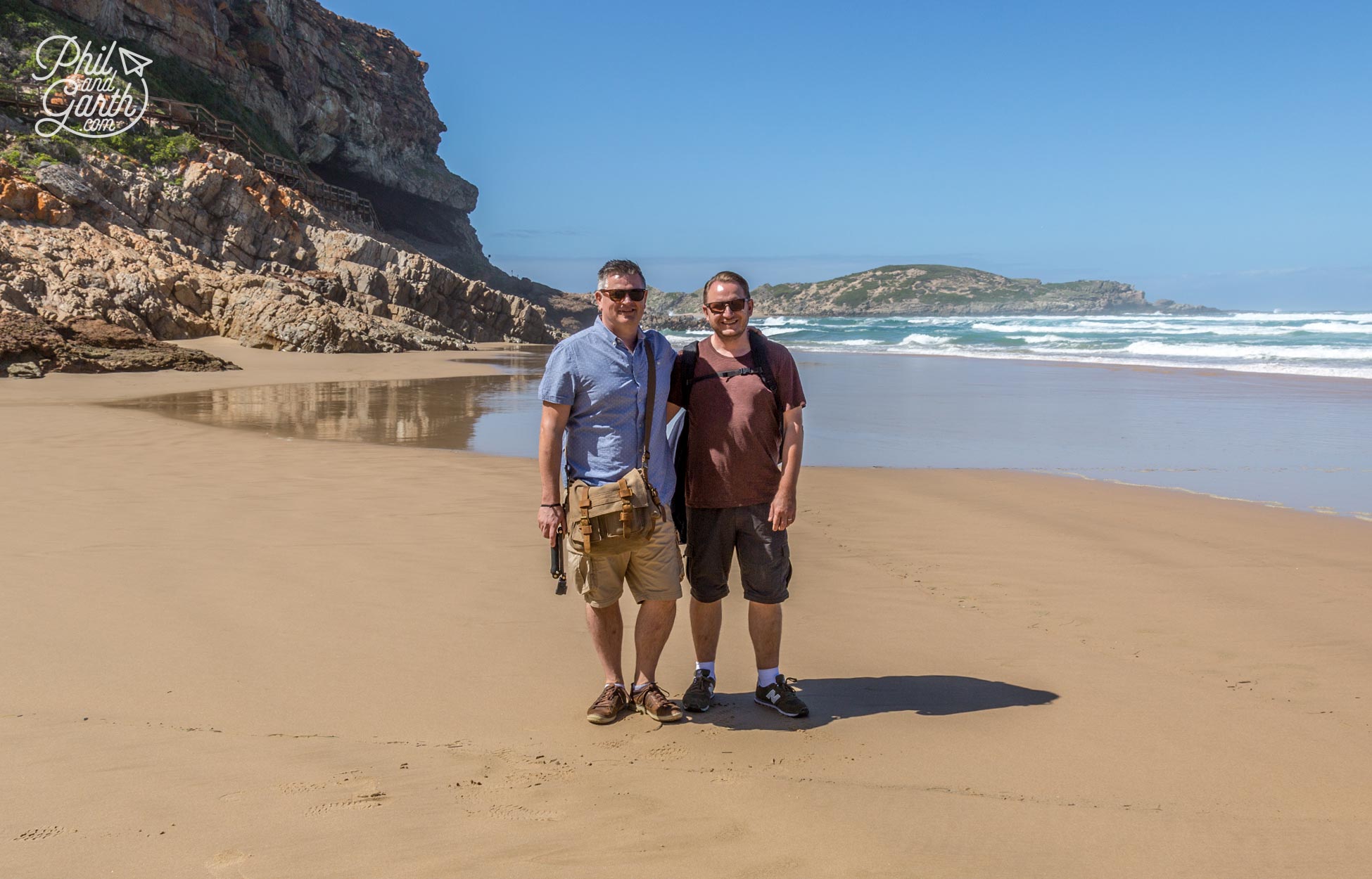
Phil and Garth on the beach at Robberg Nature Reserve

Blue Bottle jellyfish that look like plastic bags
Be careful on the beach especially if barefoot as we saw loads of poisonous ‘blue bottle’ jelly fish, they look just like blue plastic bags!

Some steep banks to negotiate

A lizard blends in with the rock, it’s possibly an Agama
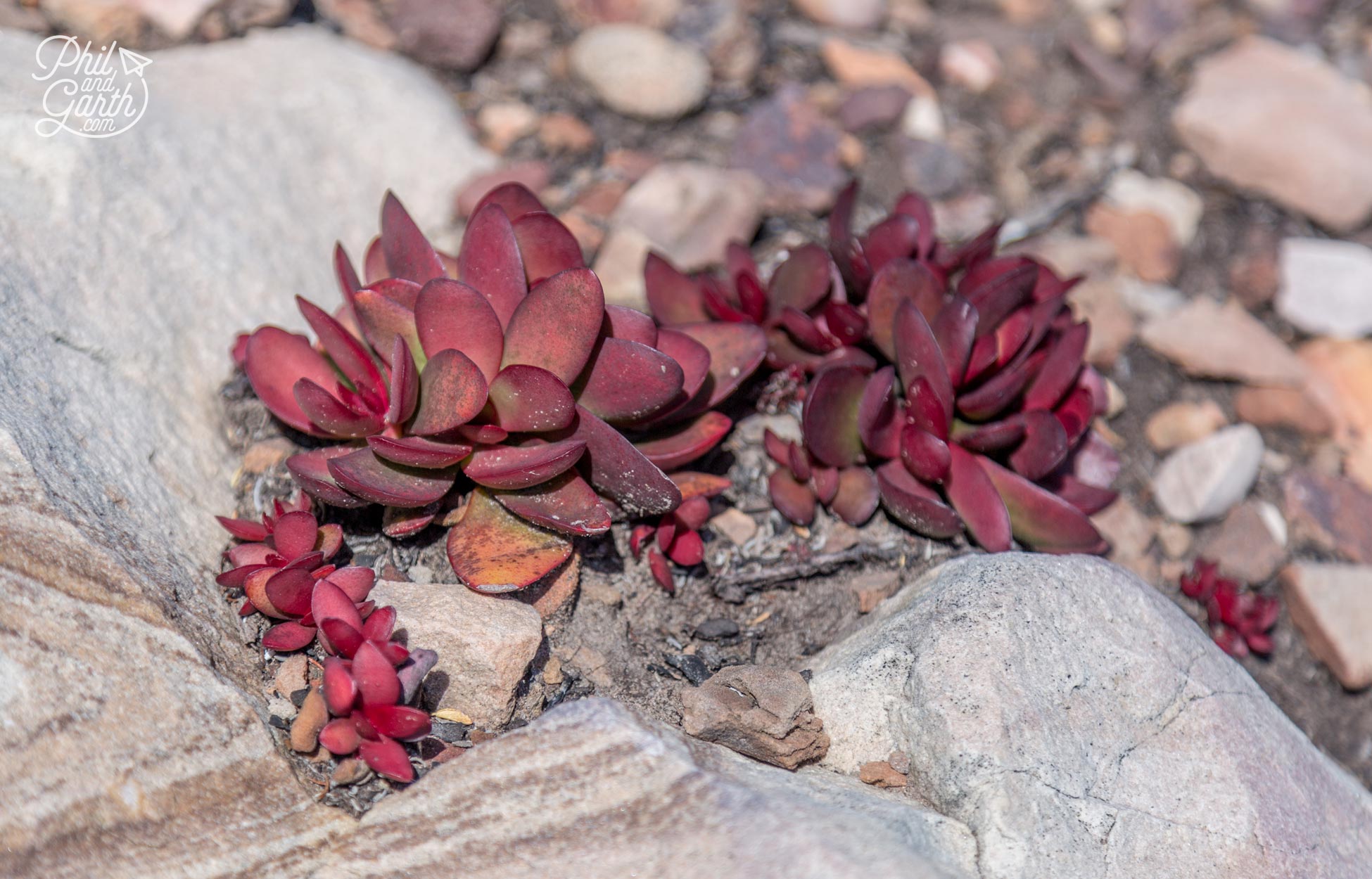
Delicate alpine looking plants in the rock

Some of the colourful fynbos flowers along the coast
Garth loved all the small flowers from the fynbos plants along the coastline. Fynbos is the name given to native wild vegetation and plants found in the Western Cape and Eastern Cape of South Africa. We visited in September which is Spring so the plants and flowers are bursting into life with colour.
Moby Dick’s for Lunch
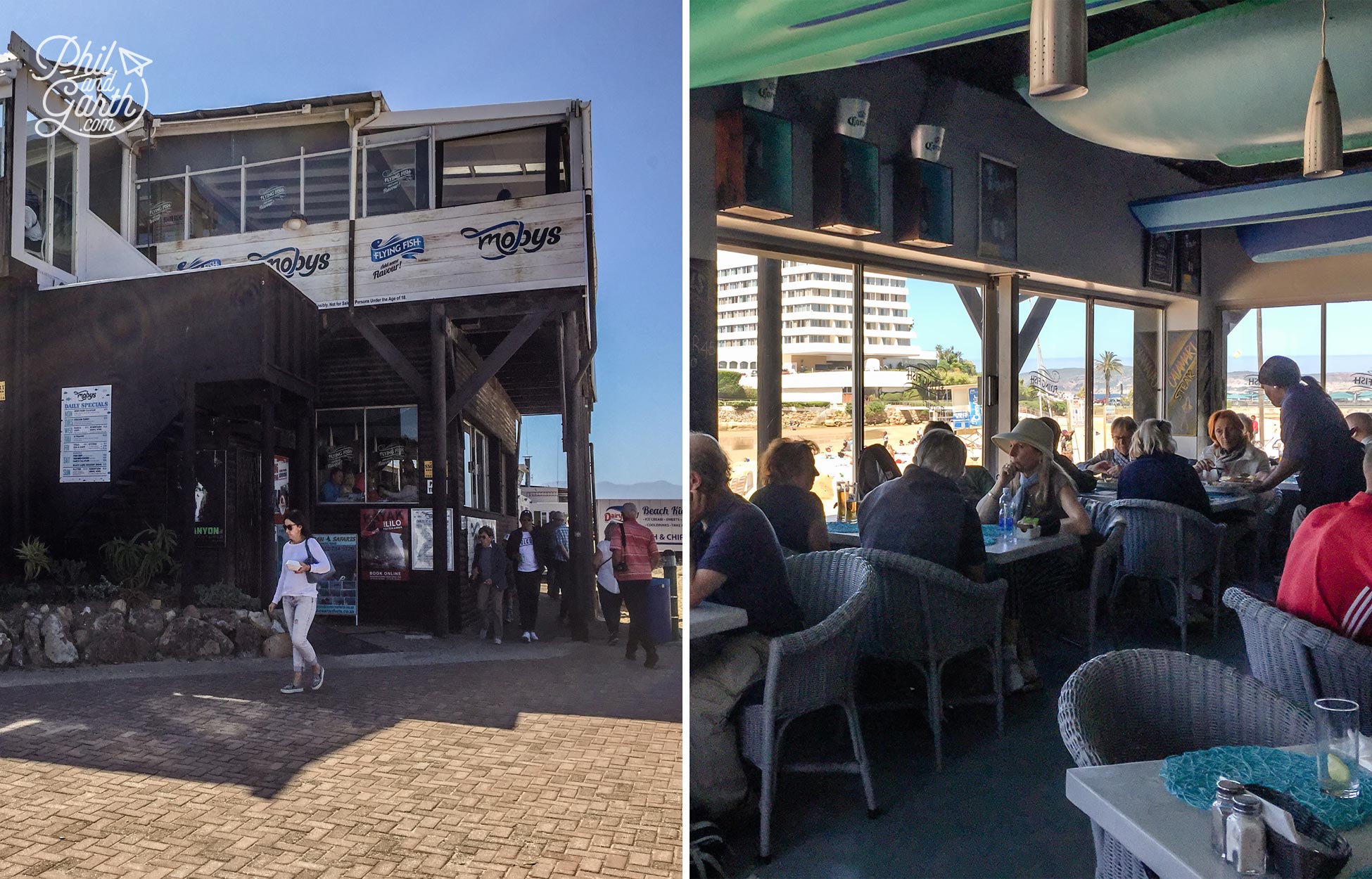
Moby’s, Plettenberg Bay
Lunch was at Moby Dick’s Seafood Grill on Central Beach back in Plettenberg Bay, famous for fresh fish and chips. We’d both recommend coming here and washing it down with a Flying Fish beer.
Bird’s Of Eden
After lunch we drove to Bird’s Of Eden. Garth was a bit sceptical and worried about seeing caged birds like the ones we once saw in Hong Kong but was pleased to see it’s not like that. This is the world’s biggest aviary, it’s classed as an animal sanctuary because it provides a wonderful home for previously caged birds. It has a giant mesh covering 6 acres of indigenous forest with a natural gorge in the middle. You walk your way through the avaiary along elevated walkways to view the birds some of them get really close. (You’re not allowed to touch them)
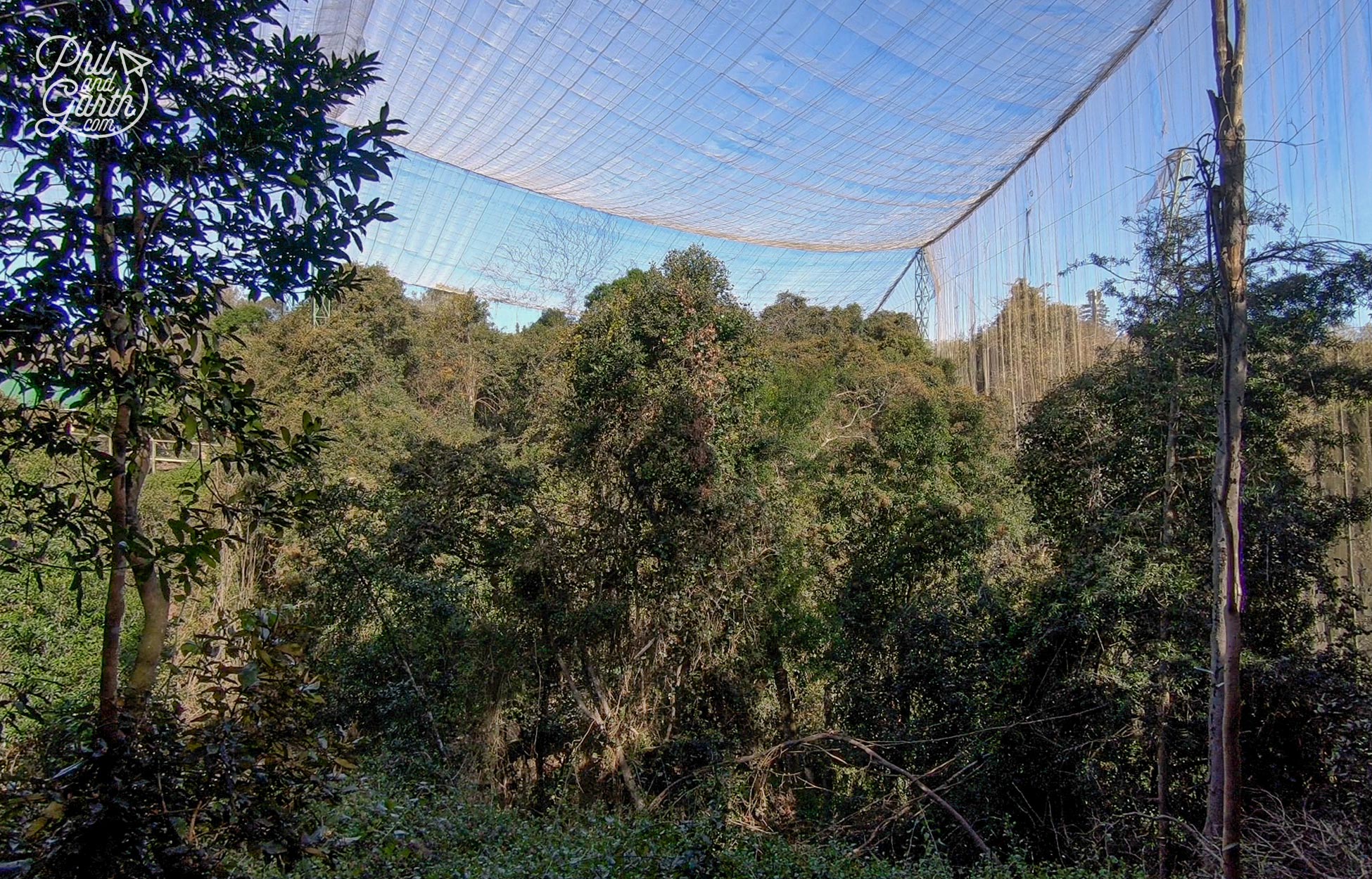
The world’s largest aviary

Fabulous colours!

Exotic birds in Bird’s Of Eden, Plettenburg Bay
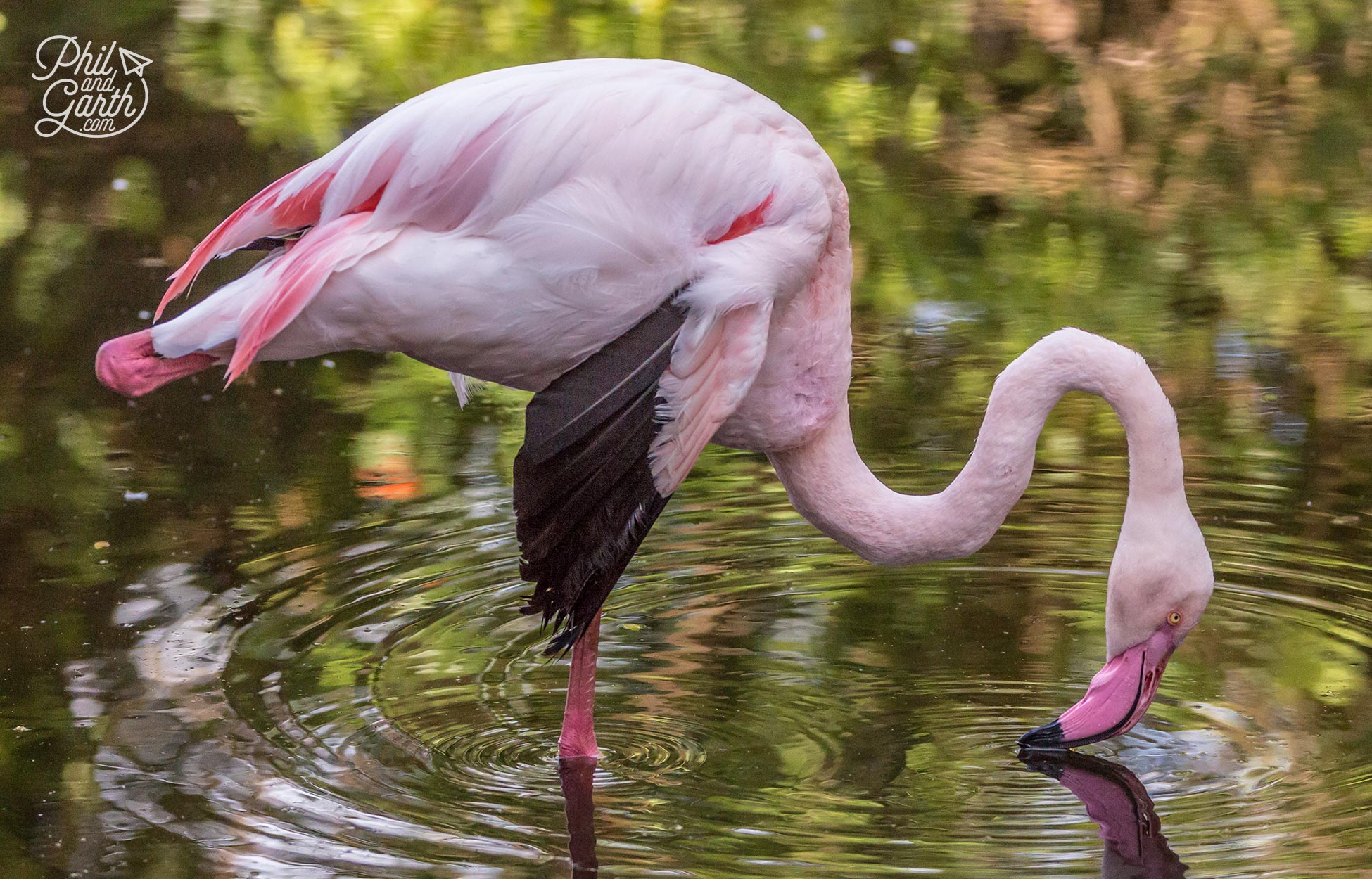
A pink flamingo takes a drink
Our group was given a guide, (they don’t usually offer guided tours) Markus was very knowledgeable and brilliant at explaining all the 200+ species we were looking at. The aviary is divided into different eco-zones like forests and wetlands, just try not to touch the handrails as they are covered in poo! If you don’t fancy seeing birds then Monkeyland next door houses primates that have been rescued from zoos or kept as pets.
A Sunset Dinner at Ristorante Enrico

Ristorante Enrico
We ended our day in Plettenburg Bay with an excellent Italian dinner at Ristorante Enrico. This place is in a really lovely spot, perfect for watching the sunset. By now we’d spent some time in South Africa so we had discovered our new favourite wine – Leopard’s Leap! Next time we come back to South Africa we must go to their winery at Franschhoek for some serious wine-tasting!
Day 3: Knysna
We left Plett behind us on day 3 and headed to Knysna (pronounced ‘nicer’) a small seaside town considered to be the one of the prettiest on the Garden Route, we thought it was quaint. Knysna is known for its oysters and some people consider it to be oyster capital of the world. They even hold an annual Oyster Festival every June.

Knysna a picturesque stop on the Garden Route
Knysna’s Waterfront
At the waterfront there are some lovely coffee shops, bars and restaurants plus nice shopping opportunities in boutique gift shops and art galleries.

Kayakers getting ready to head out on the water

The waterfront

Some nice waterfront homes

Plenty of shopping opportunities in Knysna
The Knysna Lagoon
The town may look like its on the sea, but it’s actually a lagoon. There’s no doubt this is the main attraction of Knysna so we took a lunch cruise to view the Knysna Heads from the water. There’s cruises all day, the sunset cruises are the most popular.
The lagoon is shallow and topped up by 5 freshwater rivers. It’s popular with local fisherman seeking out leerfish, mullet, skate and elf. In the old days the Knysna Seahorse used to thrive in the vegetation of the lagoon and estuaries. But now this sea creature is protected and listed as the most endangered seahorse in the world.

Boats bob up and down in the lagoon
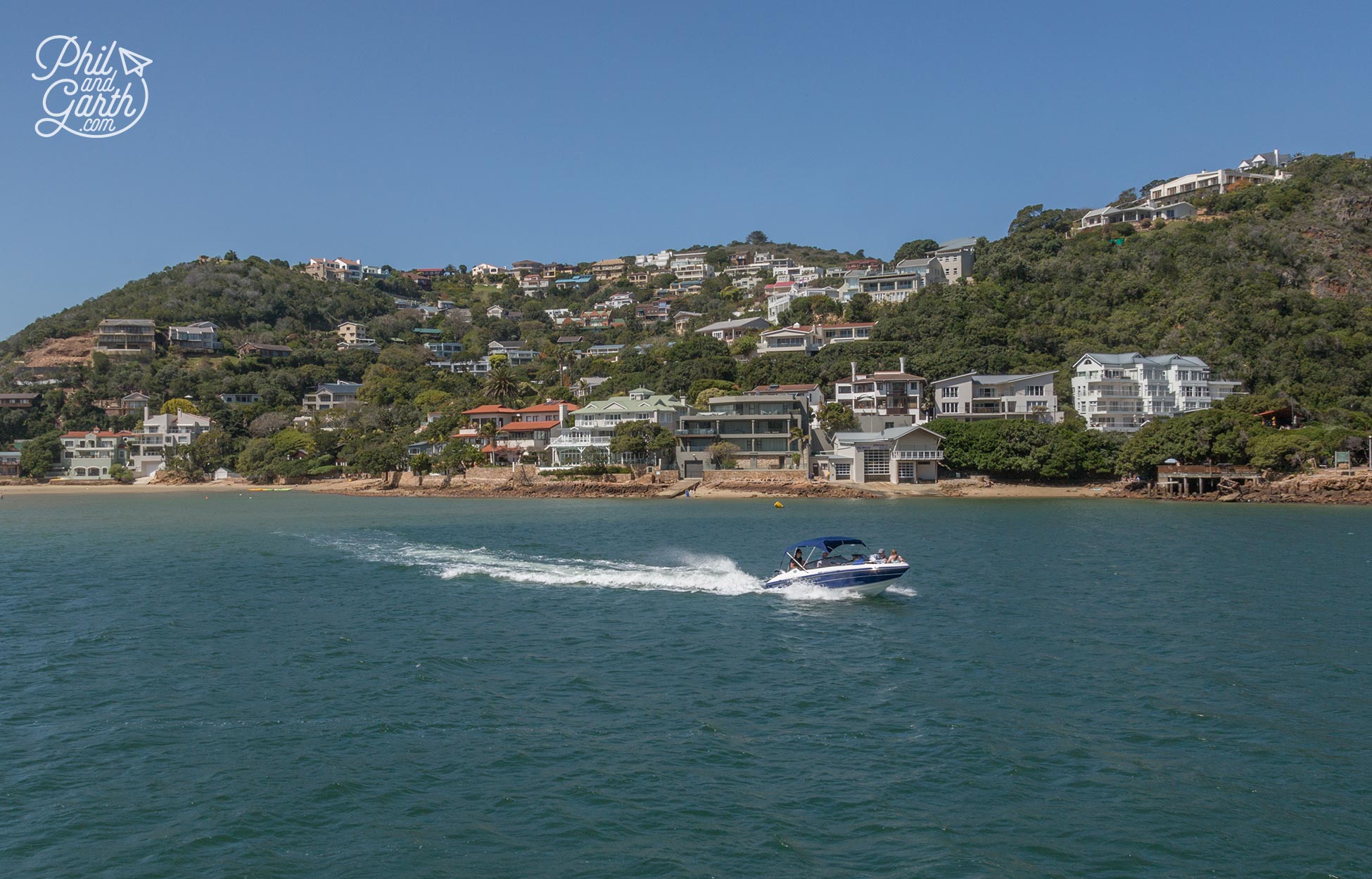
Cruising past rich mansions along Knysna’s lagoon

The Knysna Heads – 2 Sandstone cliffs protecting the lagoon from the ocean behind
Knysna Heads

Phil and Garth at Knysna Heads
In late afternoon we drove towards Knysna Heads, which takes you past some amazing beach houses in a wealthy neighbourhood. It’s a beautiful spot with views across to Knysna town. The two cliffs stand like watchmen protecting Knysna’s lagoon against the fierce Indian Ocean.

View of Knysna from Knysna Heads

We watched the sunset over one of Knysna’s islands
We had dinner back in the marina at the upscale 34 South restaurant, where Knysna Oysters are top of the menu. We both don’t really like oysters so skipped them (sorry Knysna!) and opted for the fresh fish instead.
Our Knysna Accommodation

The first time we’ve stayed in a log cabin too!
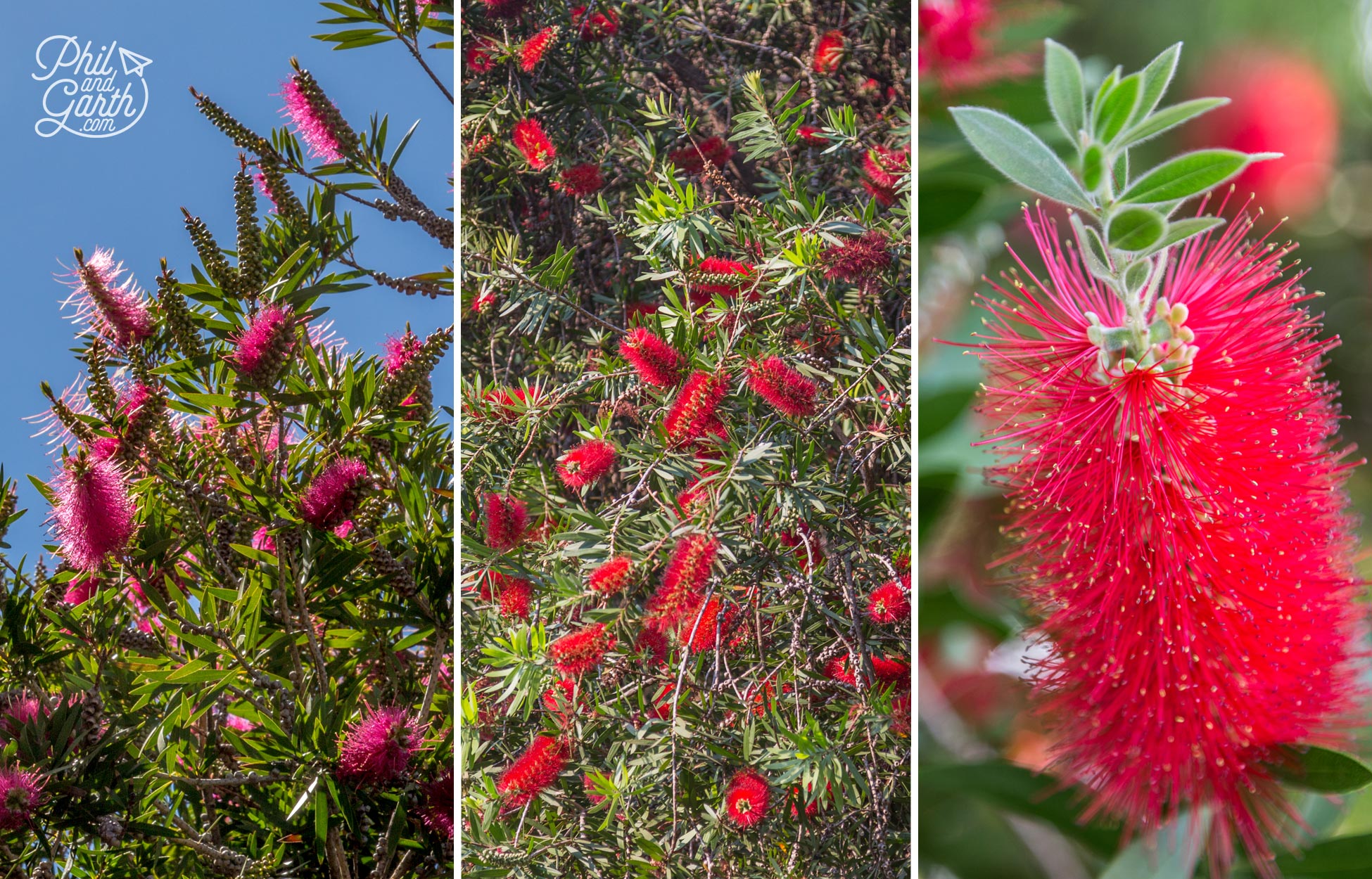
Bottlebrush plants are everywhere in Knysna and South Africa

A Level 3 water restriction leaflet in our room
There was a major water shortage in Knysna when we visited. Level 3 – which meant we could still have showers, but they’d been altered to reduce the water flow to a trickle! We were also asked to place a buckets under the shower for staff to reuse for watering plants and not to leave the tap running whilst brushing our teeth, something we now do at home. The hotel owner said the main problem is the government have not built a dam in the area, so they don’t have the infrastructure to support all the new homes being built.
Day 4: Wilderness National Park
For our last day on the Garden Route we drove to Wilderness National Park in the morning. We entered at the Ebb & Flow South section of Wilderness National Park. Our mission was to see a beautiful waterfall surrounded by giant boulders, but first we had to get there!
We took the Half-collared & Giant Kingfisher Trail – 5 miles in total and takes about 3 hours. The trail winds deep into the forest along the Touw River.

Phil working out how to cross the River Touw

Giant Kingfisher Trail sign points us to the waterfall

Long stretches of elevated walkways guide you to the waterfall

Wilderness National Park
This place was great, a really tranquil walk along the river and through the forest, the surroundings are beautifully lush. But Garth was struggling with his pain condition (Fibromyalgia) giving him some grief walking so we had to really slow down the pace. However we did finally make it to the waterfall for a quick rest and photo opportunity.

We finally made it to the waterfall!

Phil walking through a fern lined path

Lots of interesting plant life along the way
Wilderness also offers visitors canoeing, mountain biking and fishing opportunities. So that was our last stop on the Garden Route, in the afternoon we drove to Hermanus for a spot of whale watching, how exciting!
Townships
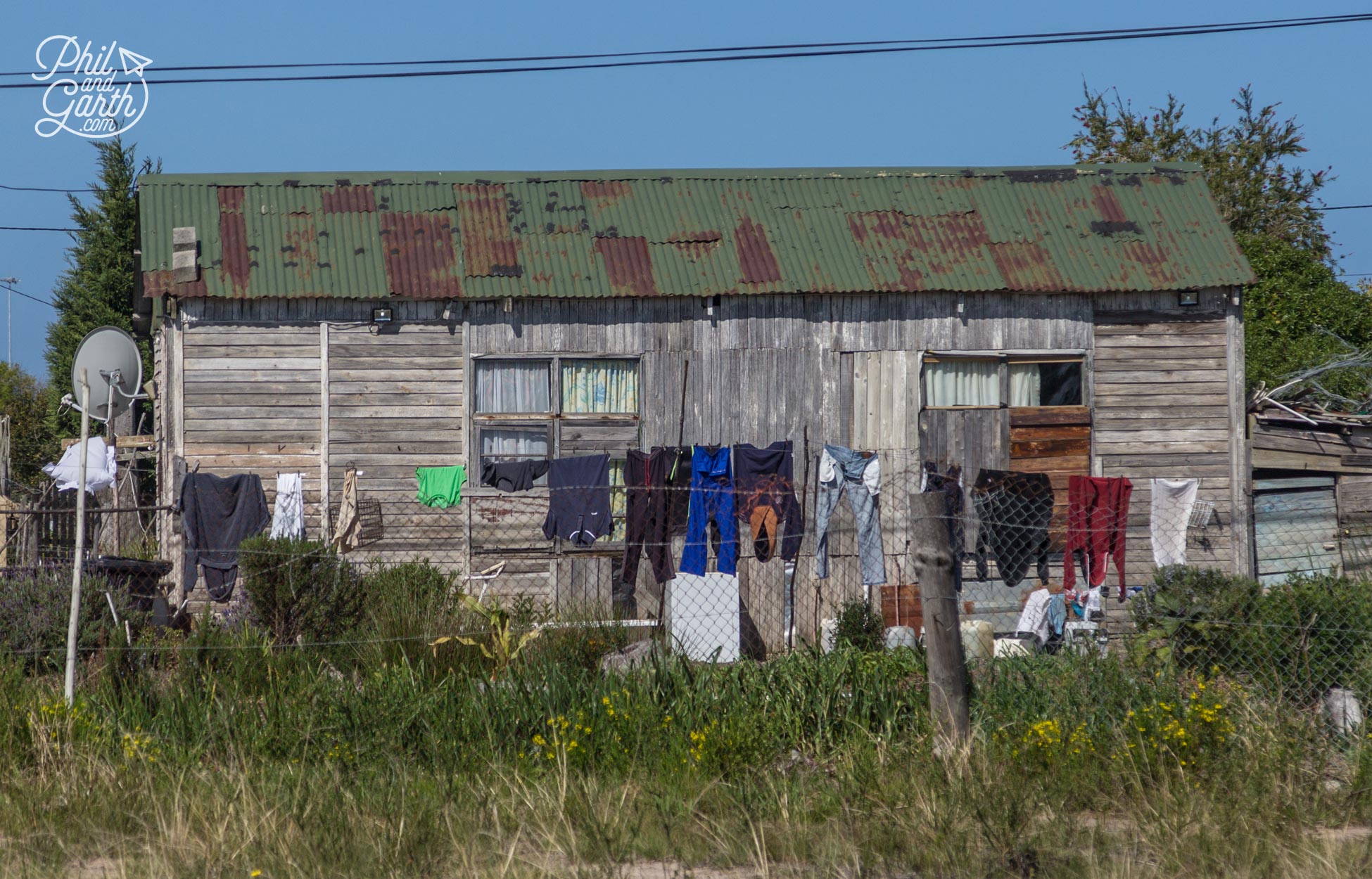
A township home just outside Plettenberg Bay
As you drive the garden route don’t be surprised to pass various townships. They vary in size – small and huge communities sit on the edge of towns. They’re not just in big cities like Johannesburg and Cape Town but also in the countryside.
Can You Do The Garden Route In 4 Days?
We jam-packed the Garden Route into 4 days because we were on a small group guided tour. We would liked to have stopped at Oudtshoorn given more time as they have have the biggest numbers of Ostrich in the world. Ideally you’d want to spend at least a week in this region, even longer if you are into hiking or birdwatching as there are some serious options here.
The Garden Route Practical Information
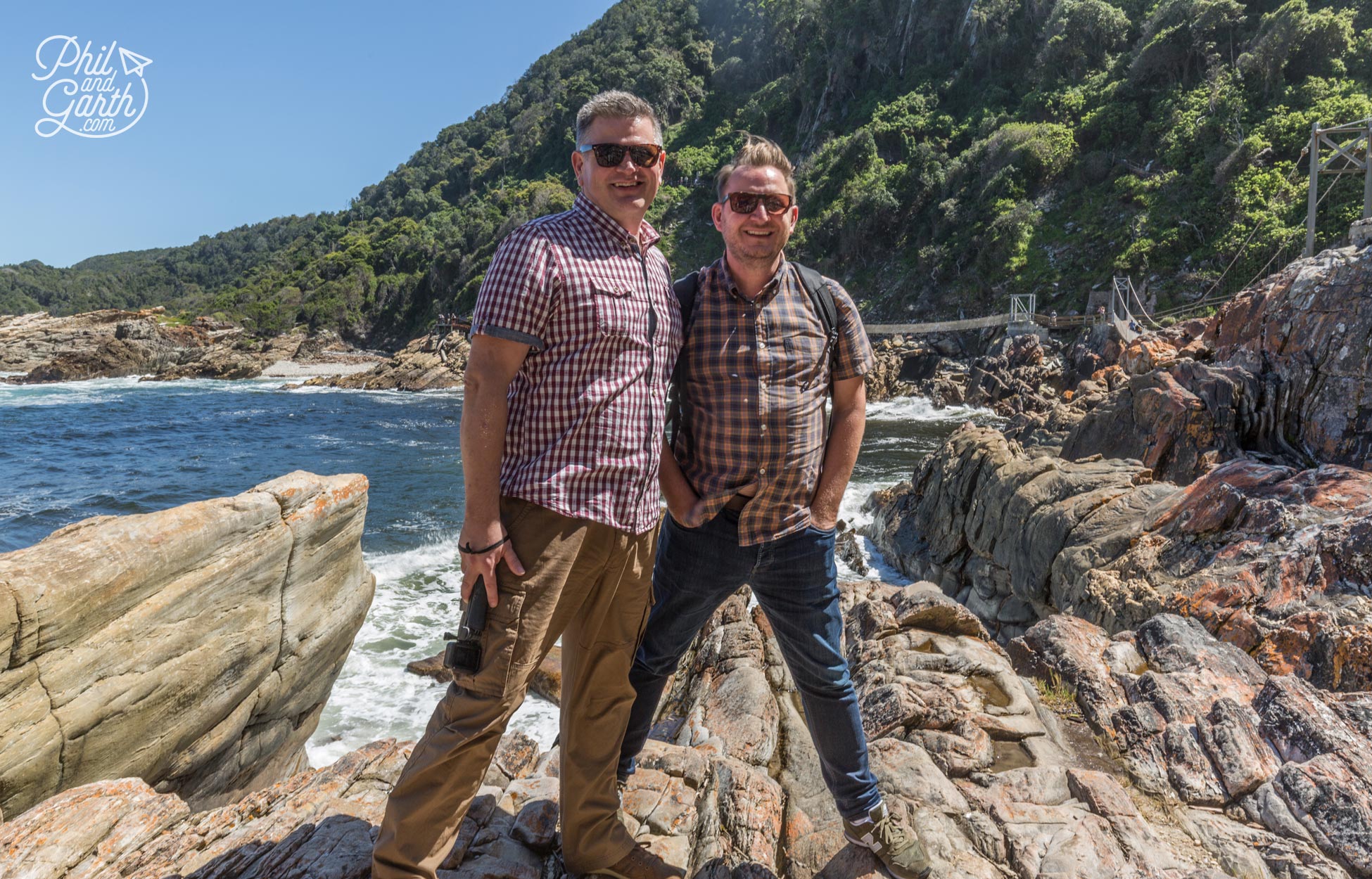
Phil and Garth’s Top 5 Garden Route Tips
Phil and Garth’s Top 5 Garden Route Tips
- Tip #1: Best time for visiting the Garden Route is September to March
- Tip #2: Remember driving is on the left, like the UK and there’s lots of roundabouts to negotiate.
- Tip #3: When parking you’ll see people in yellow jackets who will mind your car for a tip on return (10 Rand)
- Tip #4: Pack your swimming costume for a spontaneous dip at a beach.
- Tip #5: Take your zoom lens if you want to photograph seals, whales and dolphins in the sea.
How We Did It
- We booked and paid for an escorted small group tour of South Africa (South Africa Highlights with Explore.
- Port Elizabeth – 1 night at Ibhayi Guest Lodge
- Plettenberg Bay – 2 nights at The Dunes Resort
- Knysna – 1 night at Lagoona Inn







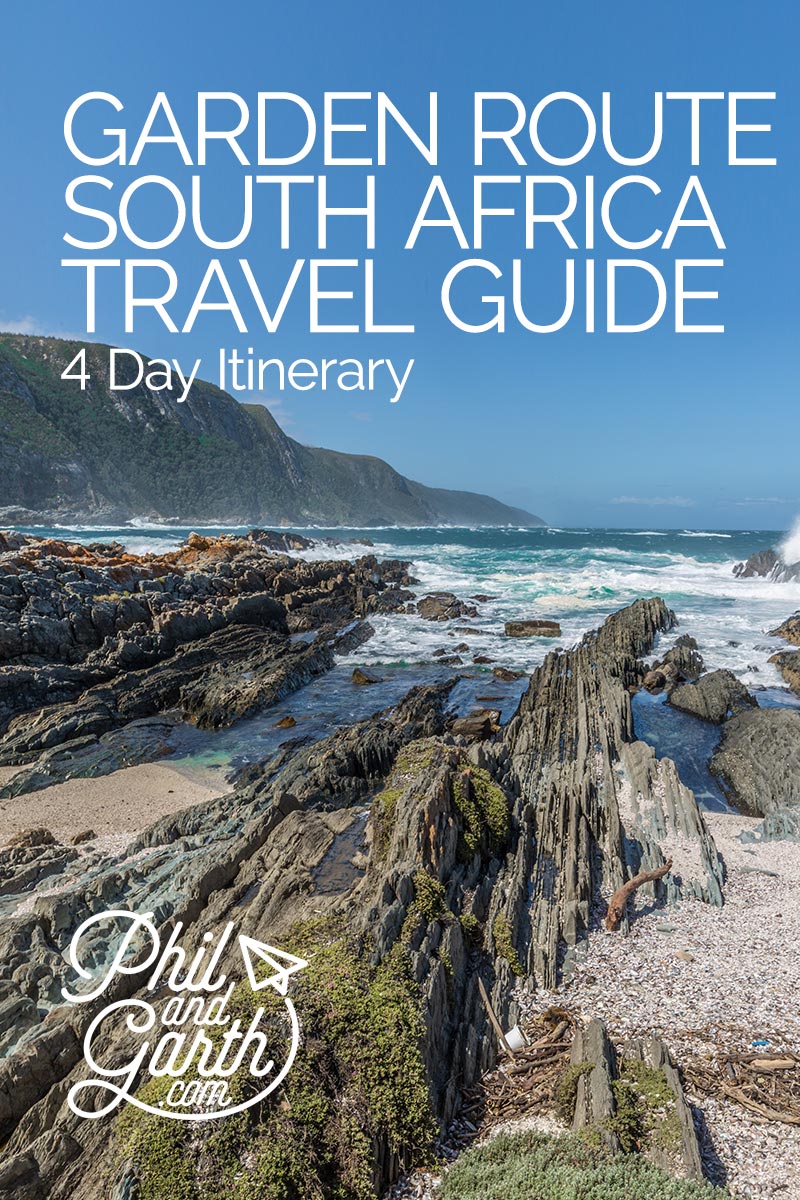


6 comments
The Blue Jellyfish are called Blue Bottles, locally. If you stand in it, it will sting which can be serious – depending on one’s allergies.
Thanks for this important information Lorne, We’ll update this post.
Plan to go there this December. Thanks Phil
Your photos are gorgeous. The Garden Route looks like a beautiful area of the world. I had never heard of it but it’s on my radar now. #feetdotravel
Oooh, can you believe the husband and I took our merry time and spend 10 days doing this stretch? It was just so lovely. It’s such a lovely part of South Africa!
#FeetDoTravel
Love love love your SA posts – your videos are amazing! Hopefully visiting friends over there next year – these posts are making me homesick!